Polysaccharides from Seedless Chestnut Rose (Rosa sterilis) Fruits: Insights into Innovative Drying Technologies and Their Structural Characteristics, Antioxidant, Antiglycation, and α-Glucosidase Inhibitory Activities
Abstract
1. Introduction
2. Materials and Methods
2.1. Materials and Reagents
2.2. Drying Procedure of RS Fruits
2.3. Extraction of Polysaccharides from RS Fruits (RSPs)
2.4. Structural Characterization of the Four RSPs
2.4.1. Determination of Chemical Composition
2.4.2. Determination of Sugar Composition
2.4.3. Homogeneity and Molecular Mass Analysis
2.4.4. Fourier Transform Infrared (FTIR) Spectroscopy and Degree of Methyl Esterification (DM) Analysis
2.4.5. Particle Size and X-ray Diffraction (XRD) Analysis
2.4.6. Determination of Thermal Properties
2.4.7. Scanning Electron Microscopy (SEM) Analysis
2.5. linoleic Acid Peroxidation Inhibition Assay
2.6. Non-Enzymatic Glycation Activity Assay
2.6.1. Non-Enzymatic Glycation of BSA
2.6.2. Analysis of Fructosamine Level
2.6.3. Analysis of Dicarbonyl Compounds Level
2.6.4. Analysis of Fluorescent AGEs
2.7. Anti-Postprandial Hyperglycemia Assay In Vitro
2.7.1. Inhibition of α-Glucosidase Activity
2.7.2. Inhibition Kinetic Analysis
2.7.3. Fluorescence Spectrum Analysis
2.8. Statistical Analysis
3. Results and Discussion
3.1. The Yield and Chemical Compositions of RSPs from Different Drying Methods
3.2. Effects of Different Drying Methods on the Structure Characteristics of RSPs
3.2.1. Molecular Weight Distribution
3.2.2. Monosaccharide Composition
3.2.3. FT-IR Spectroscopy
3.2.4. Particle Size and Crystal Structure Analysis
3.2.5. Thermal Properties
3.2.6. SEM Analysis
3.3. Antioxidant Activity in a Linoleic Acid System of RSPs from Different drying Methods
3.4. In Vitro Hypoglycemic Activity of RSPs from Different Drying Methods
3.4.1. Inhibitory Activity on α-Glucosidase
3.4.2. Inhibitory Kinetics Analysis
3.4.3. The Effects of RSPs on Fluorescent Characteristics of α-Glucosidase
3.5. In Vitro Inhibition of Non-Enzymatic Glycation of RSPs from Different Drying Methods
4. Conclusions
Author Contributions
Funding
Institutional Review Board Statement
Informed Consent Statement
Data Availability Statement
Conflicts of Interest
Abbreviations
| MVD | microwave vacuum drying |
| IRD | infrared drying |
| HD | hot air drying |
| FD | freeze-drying |
| HPAEC | high-performance anion-exchange chromatography |
| HPGPC | high-performance gel-permeation chromatography |
| FTIR | Fourier Transform Infrared Spectroscopy |
| XRD | X-ray Diffraction |
| DSC | differential scanning calorimeter |
| SEM | Scanning Electron Microscopy |
| DM | methyl esterification |
| Mw | weight average molecular weight |
| Mn | number average molecular weight |
| Mp | peak molecular weight |
References
- Li, H.; Fang, W.Y.; Wang, Z.; Chen, Y. Physicochemical, biological properties, and flavour profile of Rosa roxburghii Tratt, Pyracantha fortuneana, and Rosa laevigata Michx fruits: A comprehensive review. Food Chem. 2022, 366, 130509. [Google Scholar] [CrossRef] [PubMed]
- Wang, L.Q.; Li, Y.L.; Xia, R.; Zheng, X.Y.; Li, X.J.; Wu, S.X.; Zhang, Q.Y.; Li, S.; Deng, Y.L.; Yao, Y.Q.; et al. Component analysis and anti-pulmonary fibrosis effects of Rosa sterilis juice. Food Funct. 2022, 13, 12915–12924. [Google Scholar] [CrossRef]
- He, J.Y.; Zhang, Y.H.; Ma, N.; Zhang, X.L.; Liu, M.H.; Fu, W.M. Comparative analysis of multiple ingredients in Rosa roxburghii and R. sterilis fruits and their antioxidant activities. J. Funct. Foods 2016, 27, 29–41. [Google Scholar]
- Liu, M.H.; Zhang, Q.; Zhang, Y.H.; Lu, X.Y.; Fu, W.M.; He, J.Y. Chemical Analysis of Dietary Constituents in Rosa roxburghii and Rosa sterilis Fruits. Molecules 2016, 21, 1204. [Google Scholar] [CrossRef] [PubMed]
- Xu, J.W.; Vidyarthi, S.K.; Bai, W.B.; Pan, Z.L. Nutritional constituents, health benefits and processing of Rosa roxburghii: A review. J. Funct. Foods 2019, 60, 103456. [Google Scholar] [CrossRef]
- Chen, S.G.; Luan, L.Q.; Zhang, Y.R.; Liu, F.F.; Ye, X.Q.; Hou, Z.Q. A comparison study on polysaccharides extracted from Rosa sterilis SDShi using different methods: Structural and in vitro fermentation characterizations. Food Chem. X 2023, 17, 100533. [Google Scholar] [CrossRef] [PubMed]
- Luo, X.L.; Dan, H.L.; Li, N.; Li, Y.H.; Zhang, Y.J.; Zhao, P. A new catechin derivative from the fruits of Rosa sterilis S. D. Shi. Nat. Prod. Res. 2017, 31, 2239–2244. [Google Scholar] [CrossRef] [PubMed]
- Liu, J.; Li, C.C.; Ding, G.J.; Quan, W.X. Artificial Intelligence Assisted Ultrasonic Extraction of Total Flavonoids from Rosa sterilis. Molecules 2021, 26, 3835. [Google Scholar] [CrossRef] [PubMed]
- Chen, K.; Zhang, Q.; Yang, S.; Zhang, S.; Chen, G. Comparative Study on the Impact of Different Extraction Technologies on Structural Characteristics, Physicochemical Properties, and Biological Activities of Polysaccharides from Seedless Chestnut Rose (Rosa sterilis) Fruit. Foods 2024, 13, 772. [Google Scholar] [CrossRef]
- Tepe, T.K.; Tepe, B. The comparison of drying and rehydration characteristics of intermittent-microwave and hot-air dried-apple slices. Heat Mass Transf. 2020, 56, 3047–3057. [Google Scholar] [CrossRef]
- Harguindeguy, M.; Fissore, D. On the effects of freeze-drying processes on the nutritional properties of foodstuff: A review. Dry. Technol. 2020, 38, 846–868. [Google Scholar] [CrossRef]
- Belwal, T.; Cravotto, C.; Prieto, M.A.; Venskutonis, P.R.; Daglia, M.; Devkota, H.P.; Baldi, A.; Ezzat, S.M.; Gómez-Gómez, L.; Salama, M.M.; et al. Effects of different drying techniques on the quality and bioactive compounds of plant-based products: A critical review on current trends. Dry. Technol. 2022, 40, 1539–1561. [Google Scholar] [CrossRef]
- González-Cavieres, L.; Pérez-Won, M.; Tabilo-Munizaga, G.; Jara-Quijada, E.; Díaz-Alvarez, R.; Lemus-Mondaca, R. Advances in vacuum microwave drying (VMD) systems for food products. Trends Food Sci. Technol. 2021, 116, 626–638. [Google Scholar] [CrossRef]
- Huang, D.; Yang, P.; Tang, X.H.; Luo, L.; Sunden, B. Application of infrared radiation in the drying of food products. Trends Food Sci. Technol. 2021, 110, 765–777. [Google Scholar] [CrossRef]
- Dumpler, J.; Moraru, C.I. Microwave vacuum drying of dairy cream: Processing, reconstitution, and whipping properties of a novel dairy product. J. Dairy Sci. 2024, 107, 774–789. [Google Scholar] [CrossRef] [PubMed]
- Chen, C.; Wongso, I.; Putnam, D.; Khir, R.; Pan, Z.L. Effect of hot air and infrared drying on the retention of cannabidiol and terpenes in industrial hemp (Cannabis sativa L.). Ind. Crops Prod. 2021, 172, 114051. [Google Scholar] [CrossRef]
- Wu, B.G.; Qiu, C.C.; Guo, Y.T.; Zhang, C.H.; Li, D.; Gao, K.; Ma, Y.J.; Ma, H.L. Comparative Evaluation of Physicochemical Properties, Microstructure, and Antioxidant Activity of Jujube Polysaccharides Subjected to Hot Air, Infrared, Radio Frequency, and Freeze Drying. Agriculture 2022, 12, 1606. [Google Scholar] [CrossRef]
- Zhang, Y.K.; Shi, Q.W.; Jiang, W.; Yao, J.; Zeng, J.Y.; Wang, W.M.; Zhang, Y.J. Comparison of the chemical composition and antioxidant stress ability of polysaccharides from Auricularia auricula under different drying methods. Food Funct. 2022, 13, 2938–2951. [Google Scholar] [CrossRef]
- Zhang, Y.; Pan, Y.N.; Li, J.Q.; Zhang, Z.; He, Y.M.; Yang, H.J.; Zhou, P. Inhibition on α-Glucosidase Activity and Non-Enzymatic Glycation by an Anti-Oxidative Proteoglycan from Ganoderma lucidum. Molecules 2022, 27, 1457. [Google Scholar] [CrossRef]
- Garay-Sevilla, M.E.; Beeri, M.S.; de la Maza, M.P.; Rojas, A.; Salazar-Villanea, S.; Uribarri, J. The potential role of dietary advanced glycation endproducts in the development of chronic non-infectious diseases: A narrative review. Nutr. Res. Rev. 2020, 33, 298–311. [Google Scholar] [CrossRef]
- Cao, X.Y.; Xia, Y.; Liu, D.; He, Y.L.; Mu, T.; Huo, Y.P.; Liu, J.L. Inhibitory effects of Lentinus edodes mycelia polysaccharide on α-glucosidase, glycation activity and high glucose-induced cell damage. Carbohydr. Polym. 2020, 246, 116659. [Google Scholar] [CrossRef]
- Amamou, S.; Lazreg, H.; Hafsa, J.; Majdoub, H.; Rihouey, C.; Le Cerf, D.; Achour, L. Effect of extraction condition on the antioxidant, antiglycation and α-amylase inhibitory activities of Opuntia macrorhiza fruit peels polysaccharides. LWT Food Sci. Technol. 2020, 127, 109411. [Google Scholar] [CrossRef]
- Hafsa, J.; Hammi, K.M.; Le Cerf, D.; Limem, K.; Majdoub, H.; Charfeddine, B. Characterization, antioxidant and antiglycation properties of polysaccharides extracted from the medicinal halophyte Carpobrotus edulis L. Int. J. Biol. Macromol. 2018, 107, 833–842. [Google Scholar] [CrossRef] [PubMed]
- An, K.; Wu, J.; Xiao, H.; Hu, T.; Yu, Y.; Yang, W.; Xiao, G.; Xu, Y. Effect of various drying methods on the physicochemical characterizations, antioxidant activities and hypoglycemic activities of lychee (Litchi chinensi Sonn.) pulp polysaccharides. Int. J. Biol. Macromol. 2022, 220, 510–519. [Google Scholar] [CrossRef] [PubMed]
- Dubois, M.; Gilles, K.A.; Hamilton, J.K.; Rebers, P.A.; Smith, F. Colorimetric method for determination of sugars and related substances. Anal. Chem. 1956, 28, 350–356. [Google Scholar] [CrossRef]
- Blumenkr, N.; Asboehan, G. New method for quantitative-determination of uronic acids. Anal. Biochem. 1973, 54, 484–489. [Google Scholar] [CrossRef]
- Zor, T.; Seliger, Z. Linearization of the bradford protein assay increases its sensitivity: Theoretical and experimental studies. Anal. Biochem. 1996, 236, 302–308. [Google Scholar] [CrossRef]
- Peng, Z.C.; Tian, S.R.; Li, H.L.; Zhu, L.P.; Zhao, Z.M.; Zheng, G.D.; Wen, Q.Y.; Tian, H.R.; Yang, D.P. Extraction, characterization, and antioxidant properties of cell wall polysaccharides from the pericarp of Citrus reticulata cv. Chachiensis. Food Hydrocoll. 2023, 136, 108237. [Google Scholar] [CrossRef]
- Chaouch, M.A.; Hafsa, J.; Rihouey, C.; Le Cerf, D.; Majdoub, H. Depolymerization of polysaccharides from Opuntia ficus indica: Antioxidant and antiglycated activities. Int. J. Biol. Macromol. 2015, 79, 779–786. [Google Scholar] [CrossRef]
- Dou, Z.M.; Chen, C.; Huang, Q.; Fu, X. Comparative study on the effect of extraction solvent on the physicochemical properties and bioactivity of blackberry fruit polysaccharides. Int. J. Biol. Macromol. 2021, 183, 1548–1559. [Google Scholar] [CrossRef]
- Zeng, L.; Ding, H.F.; Hu, X.; Zhang, G.W.; Gong, D.M. Galangin inhibits α-glucosidase activity and formation of non-enzymatic glycation products. Food Chem. 2019, 271, 70–79. [Google Scholar] [CrossRef]
- Chong, O.Y.; Chai, W.M.; Xu, X.H.; Shuang, S.; Wei, Q.M.; Qian, H.; Zou, Z.R. Inhibitory potential of proanthocyanidins from the fruit pulp of Clausena lansium (Lour.) Skeels against α-glucosidase and non-enzymatic glycation: Activity and mechanism. Process Biochem. 2020, 91, 364–373. [Google Scholar]
- Spinola, V.; Llorent-Martinez, E.J.; Castilho, P.C. Inhibition of α-amylase, α-glucosidase and pancreatic lipase by phenolic compounds of Rumex maderensis (Madeira sorrel). Influence of simulated gastrointestinal digestion on hyperglycaemia-related damage linked with aldose reductase activity and protein glycation. LWT Food Sci. Technol. 2020, 118, 108727. [Google Scholar]
- Jia, Y.N.; Xue, Z.H.; Wang, Y.J.; Lu, Y.P.; Li, R.L.; Li, N.N.; Wang, Q.R.; Zhang, M.; Chen, H.X. Chemical structure and inhibition on α-glucosidase of polysaccharides from corn silk by fractional precipitation. Carbohydr. Polym. 2021, 252, 12. [Google Scholar] [CrossRef] [PubMed]
- Dezhampanah, H.; Firouzi, R. An Investigation on intermolecular interaction between Bis (indolyl) methane and HSA and BSA using multi technique methods. J. Biomol. Struct. Dyn. 2017, 35, 3615–3626. [Google Scholar] [CrossRef]
- Liu, W.; Li, F.; Wang, P.; Liu, X.; He, J.J.; Xian, M.L.; Zhao, L.; Qin, W.; Gan, R.Y.; Wu, D.T. Effects of drying methods on the physicochemical characteristics and bioactivities of polyphenolic-protein-polysaccharide conjugates from Hovenia dulcis. Int. J. Biol. Macromol. 2020, 148, 1211–1221. [Google Scholar] [CrossRef]
- Chen, G.J.; Li, C.F.; Wang, S.S.; Mei, X.F.; Zhang, H.X.; Kan, J.Q. Characterization of physicochemical properties and antioxidant activity of polysaccharides from shoot residues of bamboo (Chimonobambusa quadrangularis): Effect of drying procedures. Food Chem. 2019, 292, 281–293. [Google Scholar] [CrossRef]
- Fu, Y.; Feng, K.L.; Wei, S.Y.; Xiang, X.R.; Ding, Y.; Li, H.Y.; Zhao, L.; Qin, W.; Gan, R.Y.; Wu, D.T. Comparison of structural characteristics and bioactivities of polysaccharides from loquat leaves prepared by different drying techniques. Int. J. Biol. Macromol. 2020, 145, 611–619. [Google Scholar] [CrossRef]
- Dong, H.L.; Dai, T.T.; Liang, L.; Deng, L.Z.; Liu, C.M.; Li, Q.; Liang, R.H.; Chen, J. Physicochemical properties of pectin extracted from navel orange peel dried by vacuum microwave. LWT Food Sci. Technol. 2021, 151, 112100. [Google Scholar] [CrossRef]
- Yao, J.Q.; Yang, C.; Shi, K.X.; Liu, Y.Z.; Xu, G.; Pan, S.Y. Effect of pulp cell wall polysaccharides on citrus fruit with different mastication traits. Food Chem. 2023, 429, 136740. [Google Scholar] [CrossRef]
- Wang, W.; Ma, X.; Jiang, P.; Hu, L.; Zhi, Z.; Chen, J.; Ding, T.; Ye, X.; Liu, D. Characterization of pectin from grapefruit peel: A comparison of ultrasound-assisted and conventional heating extractions. Food Hydrocoll. 2016, 61, 730–739. [Google Scholar] [CrossRef]
- Ferguson, K.; da Cruz, M.A.; Ferrarezi, R.; Dorado, C.; Bai, J.H.; Cameron, R.G. Impact of Huanglongbing (HLB) on grapefruit pectin yield and quality during grapefruit maturation. Food Hydrocoll. 2021, 113, 106553. [Google Scholar] [CrossRef]
- Olawuyi, I.F.; Kim, S.R.; Hahn, D.; Lee, W.Y. Influences of combined enzyme-ultrasonic extraction on the physicochemical characteristics and properties of okra polysaccharides. Food Hydrocoll. 2020, 100, 105396. [Google Scholar] [CrossRef]
- Kpodo, F.M.; Agbenorhevi, J.K.; Alba, K.; Bingham, R.J.; Oduro, I.N.; Morris, G.A.; Kontogiorgos, V. Pectin isolation and characterization from six okra genotypes. Food Hydrocoll. 2017, 72, 323–330. [Google Scholar] [CrossRef]
- Wang, Y.L.; Bai, Y.X.; Ji, H.Y.; Dong, J.J.; Li, X.X.; Liu, J.L.; Jin, Z.Y. Insights into rice starch degradation by maltogenic α-amylase: Effect of starch structure on its rheological properties. Food Hydrocoll. 2022, 124, 107289. [Google Scholar] [CrossRef]
- Li, F.; Wei, Y.L.; Liang, L.; Huang, L.L.; Yu, G.Y.; Li, Q.H. A novel low-molecular-mass pumpkin polysaccharide: Structural characterization, antioxidant activity, and hypoglycemic potential. Carbohydr. Polym. 2021, 251, 117090. [Google Scholar] [CrossRef]
- Deng, Z.D.; Pan, Y.G.; Chen, W.X.; Chen, W.J.; Yun, Y.H.; Zhong, Q.P.; Zhang, W.M.; Chen, H.M. Effects of cultivar and growth region on the structural, emulsifying and rheological characteristic of mango peel pectin. Food Hydrocoll. 2020, 103, 105707. [Google Scholar] [CrossRef]
- Xu, Y.Q.; Guo, Y.Y.; Duan, S.Y.; Wei, H.; Liu, Y.S.; Wang, L.B.; Huo, X.; Yang, Y. Effects of ultrasound irradiation on the characterization and bioactivities of the polysaccharide from blackcurrant fruits. Ultrason. Sonochemistry 2018, 49, 206–214. [Google Scholar] [CrossRef] [PubMed]
- Postulkova, H.; Chamradova, I.; Pavlinak, D.; Humpa, O.; Jancar, J.; Vojtova, L. Study of effects and conditions on the solubility of natural polysaccharide gum karaya. Food Hydrocoll. 2017, 67, 148–156. [Google Scholar] [CrossRef]
- Feng, S.; Luan, D.; Ning, K.; Shao, P.; Sun, P. Ultrafiltration isolation, hypoglycemic activity analysis and structural characterization of polysaccharides from Brasenia schreberi. Int. J. Biol. Macromol. 2019, 135, 141–151. [Google Scholar] [CrossRef]
- Ji, X.; Guo, J.; Cao, T.; Zhang, T.; Liu, Y.; Yan, Y. Review on mechanisms and structure-activity relationship of hypoglycemic effects of polysaccharides from natural resources. Food Sci. Hum. Wellness 2023, 12, 1969–1980. [Google Scholar] [CrossRef]
- Cardullo, N.; Muccilli, V.; Pulvirenti, L.; Cornu, A.; Pouysegu, L.; Deffieux, D.; Quideau, S.; Tringali, C. C-glucosidic ellagitannins and galloylated glucoses as potential functional food ingredients with anti-diabetic properties: A study of α-glucosidase and α-amylase inhibition. Food Chem. 2020, 313, 126099. [Google Scholar] [CrossRef] [PubMed]
- Lin, Y.-S.; Chen, C.-R.; Wu, W.-H.; Wen, C.-L.; Chang, C.-I.; Hou, W.-C. Anti-α-glucosidase and Anti-dipeptidyl Peptidase-IV Activities of Extracts and Purified Compounds from Vitis thunbergii var. taiwaniana. J. Agric. Food Chem. 2015, 63, 6393–6401. [Google Scholar] [CrossRef] [PubMed]
- Ding, H.; Wu, X.; Pan, J.; Hu, X.; Gong, D.; Zhang, G. New Insights into the Inhibition Mechanism of Betulinic Acid on α-Glucosidase. J. Agric. Food Chem. 2018, 66, 7065–7075. [Google Scholar] [CrossRef] [PubMed]
- Wang, M.; Shi, J.; Wang, L.; Hu, Y.; Ye, X.; Liu, D.; Chen, J. Inhibitory kinetics and mechanism of flavonoids from lotus (Nelumbo nucifera Gaertn.) leaf against pancreatic α-amylase. Int. J. Biol. Macromol. 2018, 120, 2589–2596. [Google Scholar] [CrossRef] [PubMed]
- Wei, J.; Xu, D.X.; Yang, J.; Zhang, X.; Mu, T.; Wang, Q.Y. Analysis of the interaction mechanism of Anthocyanins (Aronia melanocarpa Elliot) with β-casein. Food Hydrocoll. 2018, 84, 276–281. [Google Scholar] [CrossRef]
- Chen, J.; Zhou, M.; Liu, M.; Bi, J. Physicochemical, rheological properties and in vitro hypoglycemic activities of polysaccharide fractions from peach gum. Carbohydr. Polym. 2022, 296, 119954. [Google Scholar] [CrossRef] [PubMed]
- Huang, Q.; Chai, W.M.; Ma, Z.Y.; Ou-Yang, C.; Wei, Q.M.; Song, S.; Zou, Z.R.; Peng, Y.Y. Inhibition of α-glucosidase activity and non-enzymatic glycation by tannic acid: Inhibitory activity and molecular mechanism. Int. J. Biol. Macromol. 2019, 141, 358–368. [Google Scholar] [CrossRef] [PubMed]
- Henning, C.; Glomb, M.A. Pathways of the Maillard reaction under physiological conditions. Glycoconj. J. 2016, 33, 499–512. [Google Scholar] [CrossRef]
- Khalid, M.; Petroianu, G.; Adem, A. Advanced Glycation End Products and Diabetes Mellitus: Mechanisms and Perspectives. Biomolecules 2022, 12, 542. [Google Scholar] [CrossRef]
- Yamagishi, S.; Fukami, K.; Matsui, T. Crosstalk between advanced glycation end products (AGEs)-receptor RAGE axis and dipeptidyl peptidase-4-incretin system in diabetic vascular complications. Cardiovasc. Diabetol. 2015, 14, 1475–2840. [Google Scholar] [CrossRef] [PubMed]
- Chen, Y.Y.; Tang, S.M.; Chen, Y.S.; Zhang, R.J.; Zhou, M.Z.; Wang, C.; Feng, N.J.; Wu, Q. Structure-activity relationship of procyanidins on advanced glycation end products formation and corresponding mechanisms. Food Chem. 2019, 272, 679–687. [Google Scholar] [CrossRef] [PubMed]
- Feng, N.J.; Feng, Y.N.; Tan, J.Y.; Zhou, C.; Xu, J.H.; Chen, Y.S.; Xiao, J.; He, Y.; Wang, C.; Zhou, M.Z.; et al. Inhibition of advance glycation end products formation, gastrointestinal digestion, absorption and toxicity: A comprehensive review. Int. J. Biol. Macromol. 2023, 249, 125814. [Google Scholar] [CrossRef] [PubMed]
- Zhu, R.G.; Zhang, X.Y.; Wang, Y.; Zhang, L.J.; Zhao, J.; Chen, G.; Fan, J.G.; Jia, Y.F.; Yan, F.W.; Ning, C. Characterization of polysaccharide fractions from fruit of Actinidia arguta and assessment of their antioxidant and antiglycated activities. Carbohydr. Polym. 2019, 210, 73–84. [Google Scholar] [CrossRef] [PubMed]
- Bhuiyan, M.N.I.; Mitsuhashi, S.; Sigetomi, K.; Ubukata, M. Quercetin inhibits advanced glycation end product formation via chelating metal ions, trapping methylglyoxal, and trapping reactive oxygen species. Biosci. Biotechnol. Biochem. 2017, 81, 882–890. [Google Scholar] [CrossRef]
- Katz, C.; Cohen-Or, I.; Gophna, U.; Ron, E.Z. The Ubiquitous Conserved Glycopeptidase Gcp Prevents Accumulation of Toxic Glycated Proteins. mBio 2010, 1, e00195-10. [Google Scholar] [CrossRef]

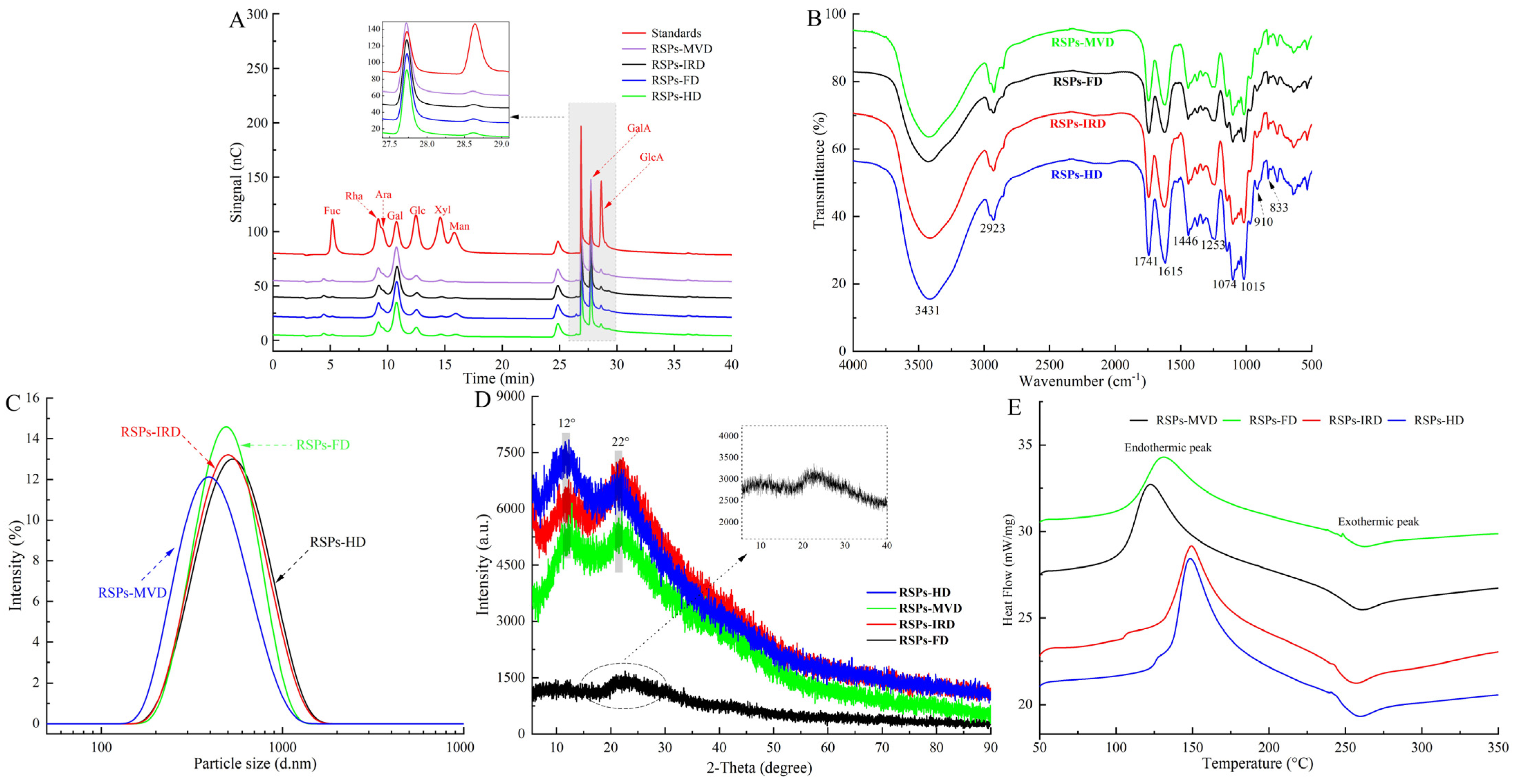
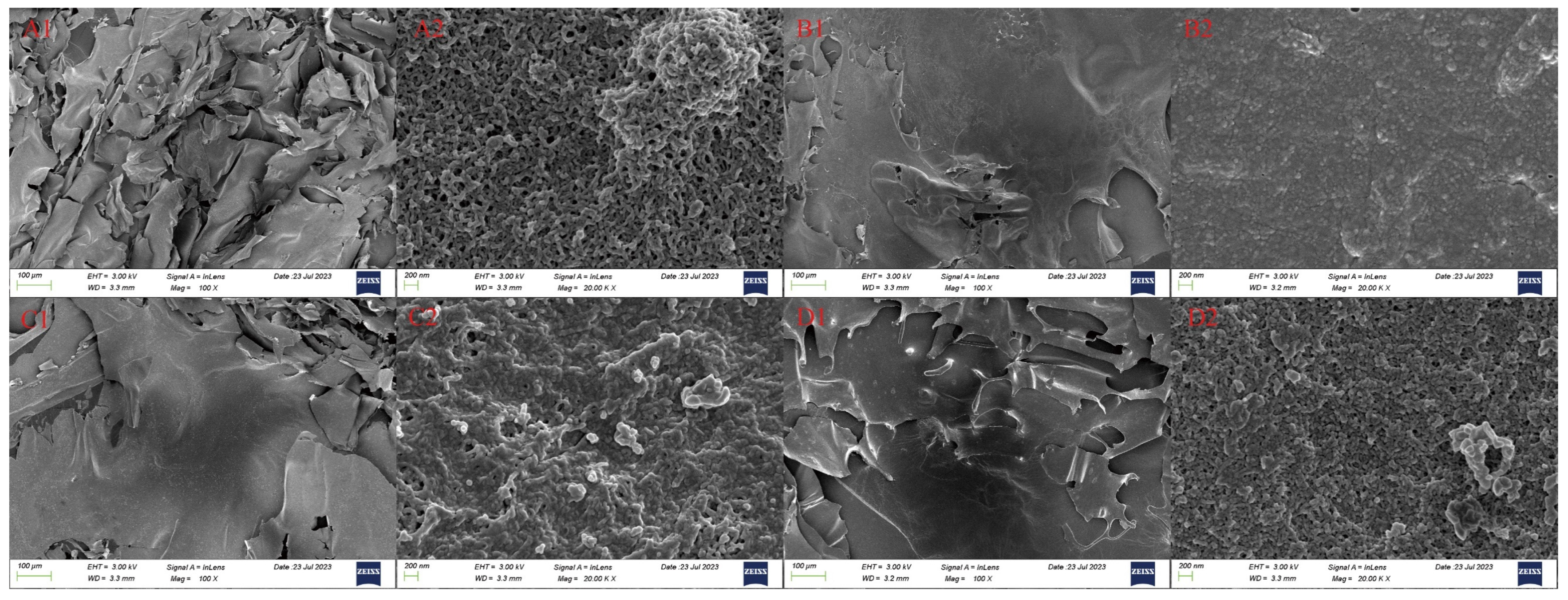
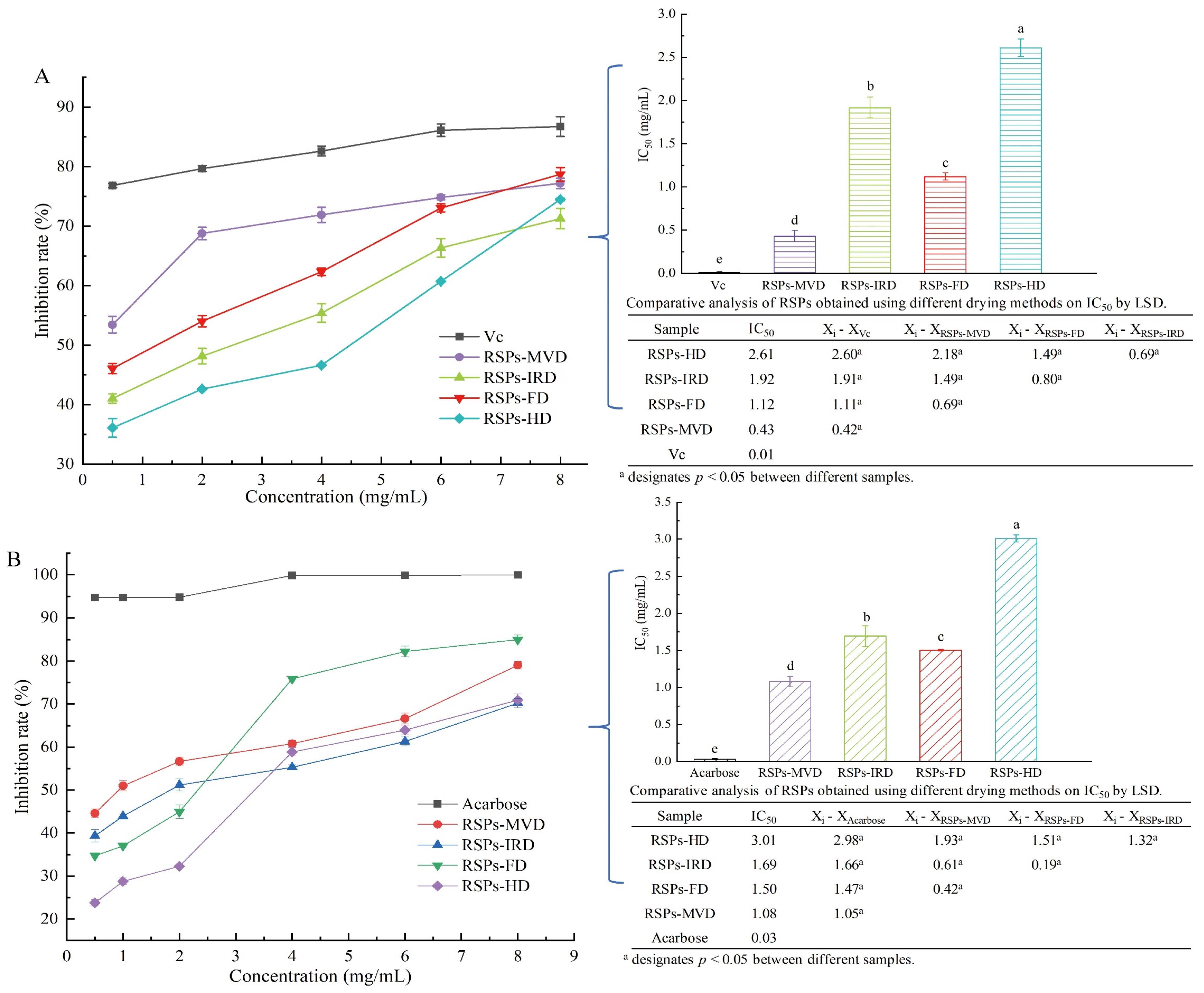
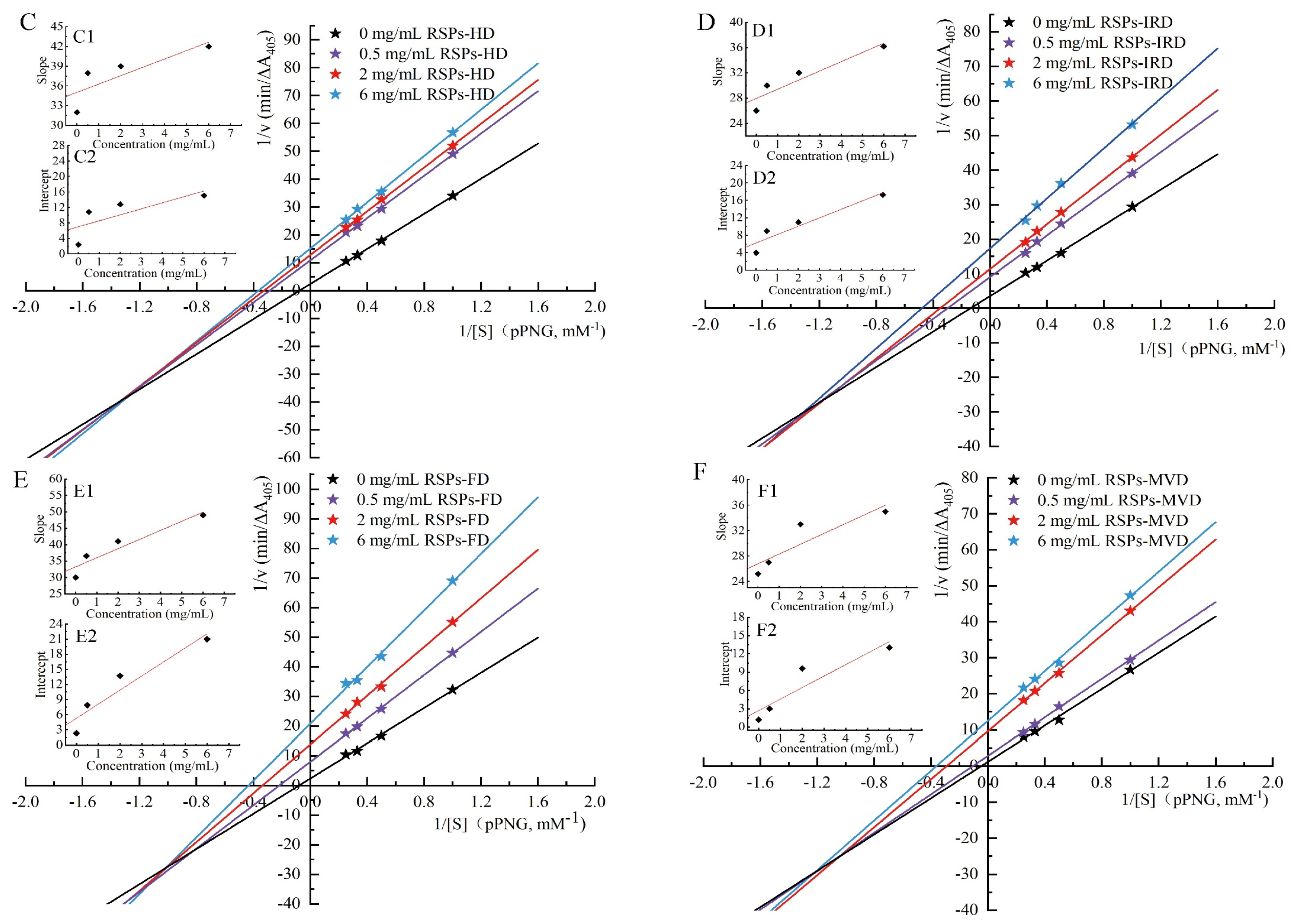

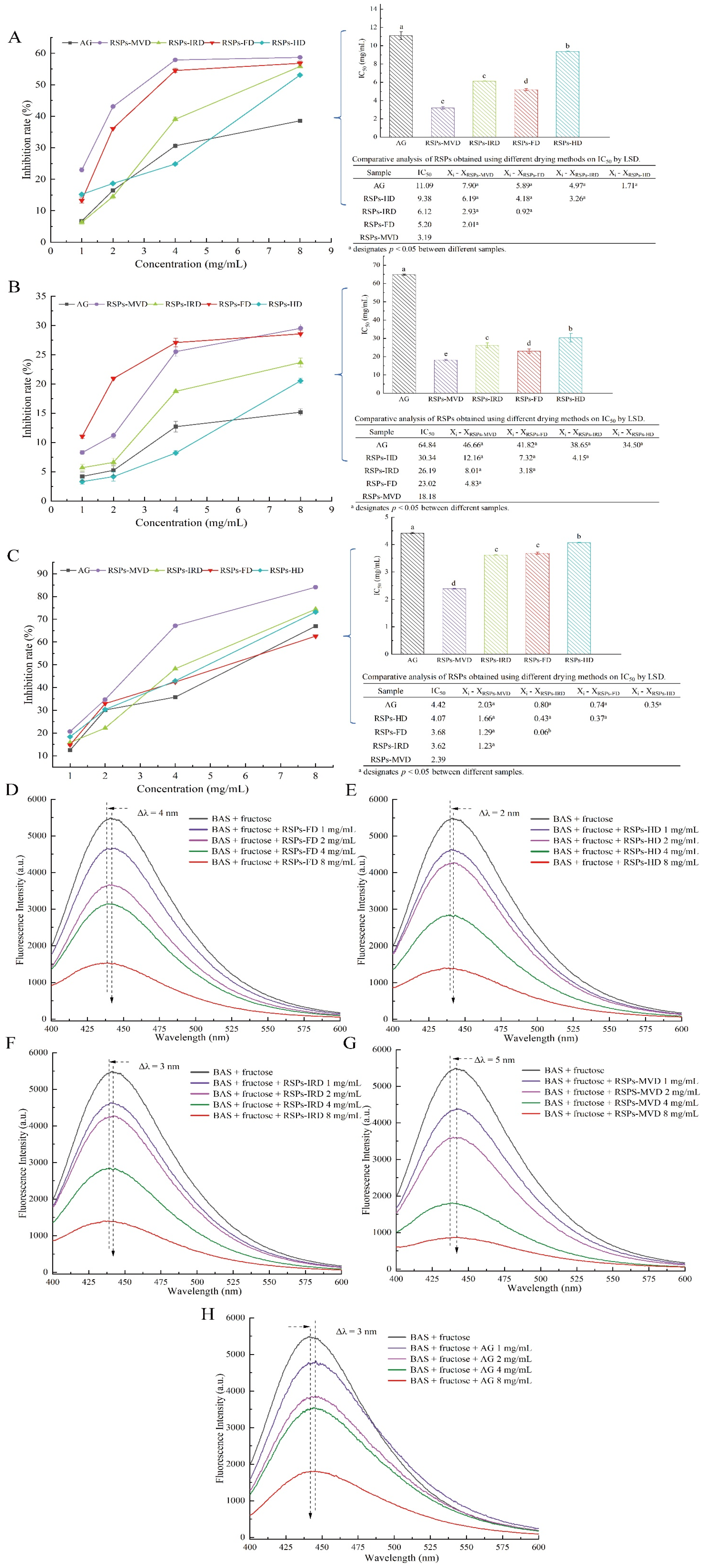
| Sample | RSPs-MVD | RSPs-IRD | RSPs-FD | RSPs-HD |
|---|---|---|---|---|
| Yield (%) | 6.93 ± 0.05 a | 4.14 ± 0.03 d | 5.89 ± 0.14 b | 4.98 ± 0.03 c |
| Chemical composition (%, w/w) | ||||
| Total sugars | 77.07 ± 2.05 a | 71.05 ± 1.26 c | 74.13 ± 0.97 b | 69.65 ± 0.42 c |
| Protein | 2.78 ± 0.36 a | 1.35 ± 0.13 b | 2.59 ± 0.13 a | 1.49 ± 0.38 b |
| Uronic acid | 41.14 ± 0.29 a | 33.76 ± 0.09 c | 37.74 ± 1.55 b | 32.48 ± 1.07 c |
| Molecular weight distribution | ||||
| Mw (kDa) | 142.51 ± 0.25 c | 197.53 ± 3.72 a | 161.64 ± 6.19 b | 202.18 ± 5.06 a |
| Mn (kDa) | 25.64 ± 0.36 b | 24.48 ± 0.80 b | 19.31 ± 0.80 b | 34.64 ± 0.19 a |
| Mp (kDa) | 79.17 ± 0.50 b | 81.18 ± 0.83 b | 67.82 ± 0.85 c | 83.11 ± 0.34 a |
| Mw/Mn | 5.56 ± 0.07 b | 8.07 ± 035 a | 8.37 ± 0.03 a | 5.84 ± 0.18 b |
| Sample | RSPs-MVD | RSPs-IRD | RSPs-FD | RSPs-HD |
|---|---|---|---|---|
| Monosaccharide constituents (molar ratios, mol %) | ||||
| Fucose (Fuc) | 0.18 ± 0.04 a | 0.09 ± 0.00 a | 0.26 ± 0.16 a | 0.22 ± 0.02 a |
| Rhamnose (Rha) | 9.98 ± 0.14 a | 9.89 ± 0.23 a | 9.96 ± 0.20 a | 9.88 ± 0.10 a |
| Arabinose (Ara) | 5.41 ± 0.08 b | 4.69 ± 0.28 c | 6.23 ± 0.21 a | 5.51 ± 0.20 b |
| Galactose (Gal) | 42.61 ± 0.58 a | 40.60 ± 1.11 b | 42.19 ± 0.41 a | 39.93 ± 0.65 b |
| Glucose (Glc) | 6.36 ± 0.08 b | 6.31 ± 0.42 b | 6.05 ± 0.23 b | 9.21 ± 0.29 a |
| Xylose (Xyl) | 1.15 ± 0.32 a | 0.13 ± 0.05 b | 1.20 ± 0.12 a | 1.34 ± 0.25 a |
| Mannose (Man) | 0.32 ± 0.21 d | 8.85 ± 0.02 a | 1.08 ± 0.12 c | 4.06 ± 0.51 b |
| Galacturonic acid (GalA) | 32.54 ± 0.59 a | 28.13 ± 0.88 b | 31.72 ± 0.92 a | 28.50 ± 0.64 b |
| Glucuronic acid (GlcA) | 1.47 ± 0.02 a | 1.31 ± 0.06 b | 1.31 ± 0.01 b | 1.35 ± 0.03 b |
| Monosaccharide ratios | ||||
| HG (%) | 22.56 ± 0.59 a | 18.24 ± 0.65 b | 21.76 ± 1.11 a | 18.62 ± 0.65 b |
| RG-I (%) | 67.98 ± 0.50 a | 65.07 ± 0.36 b | 68.34 ± 0.53 a | 65.20 ± 0.72 b |
| Linearity | 0.54 ± 0.02 a | 0.50 ± 0.02 b | 0.52 ± 0.02 ab | 0.49 ± 0.01 b |
| MR1 | 3.26 ± 0.07 a | 2.84 ± 0.02 b | 3.18 ± 0.15 a | 2.88 ± 0.07 b |
| MR2 | 4.81 ± 0.12 a | 4.58 ± 0.19 b | 4.86 ± 0.09 a | 4.60 ± 0.03 b |
| DE (%) | 56.36 ± 0.37 b | 54.68 ± 0.16 c | 58.91 ± 0.58 a | 55.74 ± 1.35 bc |
| Sample | RSPs-MVD | RSPs-IRD | RSPs-FD | RSPs-HD |
|---|---|---|---|---|
| Particle size (nm) | 427.73 ± 9.01 c | 488.80 ± 4.43 a | 454.47 ± 9.79 b | 496.00 ± 6.14 a |
| PDI (nm) | 0.24 ± 0.01 b | 0.33 ± 0.04 a | 0.34 ± 0.06 a | 0.34 ± 0.03 a |
| DSC parameters | ||||
| Tm (°C) | 134.03 ± 15.51 b | 149.31 ± 0.03 a | 138.94 ± 10.21 b | 149.19 ± 1.14 a |
| ΔHm (J/g) | 769.96 ± 19.18 a | 698.19 ± 10.93 b | 731.96 ± 35.78 ab | 528.06 ± 38.87 c |
| Tg (°C) | 259.11 ± 0.25 a | 254.96 ± 0.01 b | 259.98 ± 0.31 a | 258.81 ± 0.09 a |
| ΔHg (J/g) | 25.22 ± 3.05 a | 15.77 ± 0.58 c | 18.61 ± 3.05 b | 14.48 ± 2.05 c |
| Sample | Concentration (mg/mL) | Vmax (ΔA405/min) | Km (mM) | Ki (mg/mL) | Kis (mg/mL) | Kis/Ki | KSV (M−1) | Kq (M−1·S−1) | Ka (M−1) | Quenching Type |
|---|---|---|---|---|---|---|---|---|---|---|
| RSPs-MVD | Control | 0.86 | 21.70 | 17.44 | 1.44 | 0.08 | 7.40 × 104 | 7.40 × 1012 | 1.78 × 103 | Static quenching |
| 0.5 | 0.35 | 9.45 | ||||||||
| 2 | 0.10 | 3.46 | ||||||||
| 6 | 0.08 | 2.77 | ||||||||
| RSPs-IRD | Control | 0.28 | 7.32 | 19.20 | 3.26 | 0.17 | 5.80 × 104 | 5.80 × 1012 | 0.14 × 103 | Static quenching |
| 0.5 | 0.11 | 3.36 | ||||||||
| 2 | 0.09 | 2.86 | ||||||||
| 6 | 0.06 | 2.09 | ||||||||
| RSPs-FD | Control | 0.44 | 13.02 | 11.97 | 1.90 | 0.16 | 7.23 × 104 | 7.23 × 1012 | 1.16 × 103 | Static quenching |
| 0.5 | 0.13 | 4.63 | ||||||||
| 2 | 0.07 | 3.00 | ||||||||
| 6 | 0.05 | 2.36 | ||||||||
| RSPs-HD | Control | 0.42 | 13.23 | 27.58 | 4.55 | 0.17 | 7.81 × 104 | 7.81 × 1012 | 0.40 × 103 | Static quenching |
| 0.5 | 0.09 | 3.50 | ||||||||
| 2 | 0.08 | 3.08 | ||||||||
| 6 | 0.07 | 2.75 |
Disclaimer/Publisher’s Note: The statements, opinions and data contained in all publications are solely those of the individual author(s) and contributor(s) and not of MDPI and/or the editor(s). MDPI and/or the editor(s) disclaim responsibility for any injury to people or property resulting from any ideas, methods, instructions or products referred to in the content. |
© 2024 by the authors. Licensee MDPI, Basel, Switzerland. This article is an open access article distributed under the terms and conditions of the Creative Commons Attribution (CC BY) license (https://creativecommons.org/licenses/by/4.0/).
Share and Cite
Chen, G.; Sun, J.; Dai, Q.; Sun, M.; Hu, P. Polysaccharides from Seedless Chestnut Rose (Rosa sterilis) Fruits: Insights into Innovative Drying Technologies and Their Structural Characteristics, Antioxidant, Antiglycation, and α-Glucosidase Inhibitory Activities. Foods 2024, 13, 2483. https://doi.org/10.3390/foods13162483
Chen G, Sun J, Dai Q, Sun M, Hu P. Polysaccharides from Seedless Chestnut Rose (Rosa sterilis) Fruits: Insights into Innovative Drying Technologies and Their Structural Characteristics, Antioxidant, Antiglycation, and α-Glucosidase Inhibitory Activities. Foods. 2024; 13(16):2483. https://doi.org/10.3390/foods13162483
Chicago/Turabian StyleChen, Guangjing, Juyan Sun, Qinghua Dai, Meiwen Sun, and Peng Hu. 2024. "Polysaccharides from Seedless Chestnut Rose (Rosa sterilis) Fruits: Insights into Innovative Drying Technologies and Their Structural Characteristics, Antioxidant, Antiglycation, and α-Glucosidase Inhibitory Activities" Foods 13, no. 16: 2483. https://doi.org/10.3390/foods13162483
APA StyleChen, G., Sun, J., Dai, Q., Sun, M., & Hu, P. (2024). Polysaccharides from Seedless Chestnut Rose (Rosa sterilis) Fruits: Insights into Innovative Drying Technologies and Their Structural Characteristics, Antioxidant, Antiglycation, and α-Glucosidase Inhibitory Activities. Foods, 13(16), 2483. https://doi.org/10.3390/foods13162483





